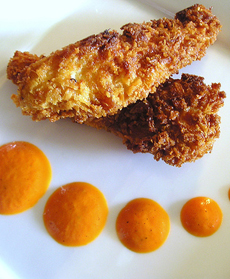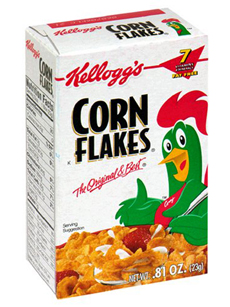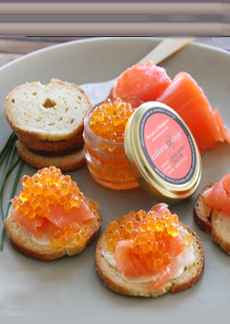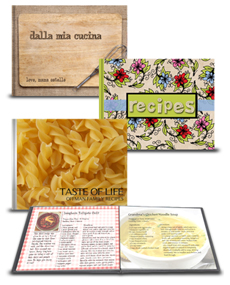|
A few days ago we wrote about the superiority of panko, Japanese breadcrumbs, over American breadcrumbs.
Yesterday, munching on some Corn Flakes for breakfast, we noticed the Corn Flake-crusted chicken recipe on the back of the box (called “Double Coated Chicken”).
Hmm, we thought: How do Corn Flakes stand up to panko?
For lunch, we made both. The verdict: While we love panko, Corn Flakes win hands down—they’re more crunchy and more flavorful.
We hadn’t used Corn Flakes breading in years, associating it with less-interesting old-school American cooking of the 1950s and 1960s.
We were wrong. We’ll now use a Corn Flakes crust on fish and other fried foods; and crunchy Corn Flakes crumbs instead of bread crumbs atop mac and cheese and other recipes.
The orange dots on the plate are a peach purée with bourbon.
> The different cuts of chicken. How many can you name?
> The history of chicken.
RECIPE: CORN FLAKES FRIED CHICKEN
Ingredients For 2 Servings
1 skinless boneless chicken breast (8 ounces)
1 large egg
1/4 cup milk
1-1/2 cups corn flakes
1/3 cup vegetable oil
1/4 + 1/4 teaspoon salt
1/4 + 1/4 teaspoon pepper
Optional garnish: Runamok Chile de Arbol Honey or other “hot honey”
Preparation
1. POUND the chicken between 2 sheets of plastic wrap to an even 1/2-inch thickness. Sprinkle chicken with 1/4 teaspoon each of salt and pepper.
2. WHISK the egg and milk together in a shallow bowl. In another bowl, crush the Corn Flakes and toss with the remaining salt and pepper.
|





